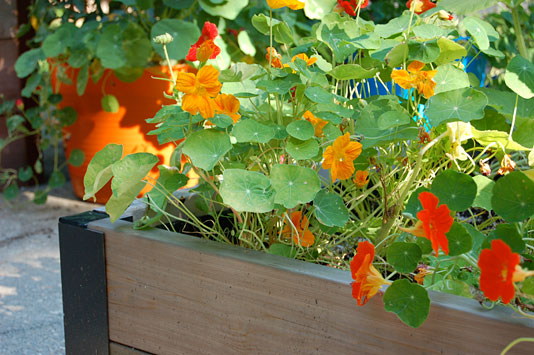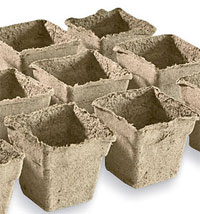






When I started working at Gardener's Supply in the 1990s, my Vermont backyard was pretty green—with grass. Today, there's just a tiny bit of the original lawn left. Most of the available space has given way to trees, shrubs, perennials, annuals and stonework. Watch a slideshow of my garden in Burlington, VT.
In addition to my work at Gardener's Supply, I work in the gardening division at Church Hill Landscapes. In that role, I maintain dozens of gardens and learn a lot in the process. I believe that all gardening is good gardening.

Not only are nasturtiums beautiful, they are edible.
‘WHAT are some easy annuals to start from seed?"
When I get that question, I always include nasturtiums on my list of suggestions. The seeds are fairly large and they can be planted right in the garden. To get an earlier start, you can plant indoors.
Also known as "direct sowing," this technique is sometimes used instead of planting indoors. It's a good choice for seeds that don't require a lot of coddling, or seedlings that suffer from transplant shock.
In the case of nasturtiums, it's convenient because you can plant them right where you want them to grow and never have to transplant. Just wait till the danger of frost has passed. Not sure of the date in your area? Use the Zip Code look-up at Dave's Garden. In hot climates, choose a site that's shaded from hot afternoon sun. Nasturtium seeds are usually planted an inch deep and about 10 inches apart. You can plant them closer together and then move them once the seedlings have several sets of leaves. Always check the seed packet for specifics. As for soil, nasturtiums are not picky and will thrive even in poor soil as long as they are watered regularly.
Direct sowing is sometimes risky because you might pull up the seedlings when you're weeding the bed. To prevent accidental weeding, mark the planting site with a label. Because of the distinctive foliage, nasturtium seedlings are easy to spot.
If you want to start with larger plants — and get earlier blooms — start the seeds indoors.

Cowpots
Because they are large seeds, I like to start with a larger pot, such as the 2-3/4" or 3" Cowpots. Put two seeds (1" deep) in each pot and grow them under lights or in a bright location, such as a south-facing window. It takes about 10 to 12 days for nasturtiums to germinate. When the seedlings have a few sets of leaves, pinch out the weaker seedling, leaving one per pot. Why plant two seedlings when you're going to pluck out the weaker one? It's mostly for insurance, in case one of the seeds fails to germinate. If you're feeling confident about your seed source — or thrifty — go with smaller pots and plant one seed in each.
When the weather moderates and nighttime temperatures are in the 50s, I harden off the seedlings. This involves moving them outdoors during the day and bringing them in at night. After a couple days, I plant them in the garden. To reduce transplant shock, I tear off the top edge of the Cowpot and plant the seedling — pot and all. It's important that the top edge of the pot is buried to prevent soil moisture from wicking away from the seedling.
Nasturtiums are fairly carefree, but it's important to keep them watered during dry periods. They do well in containers and windowboxes. Let the soil get dry between waterings, but don't let it dry out.
Nasturtiums have edible flowers that taste peppery, like watercress. All colors and varieties are tasty in salads or as garnishes. Leaves can be eaten, too.
Copyright © www.100flowers.win Botanic Garden All Rights Reserved